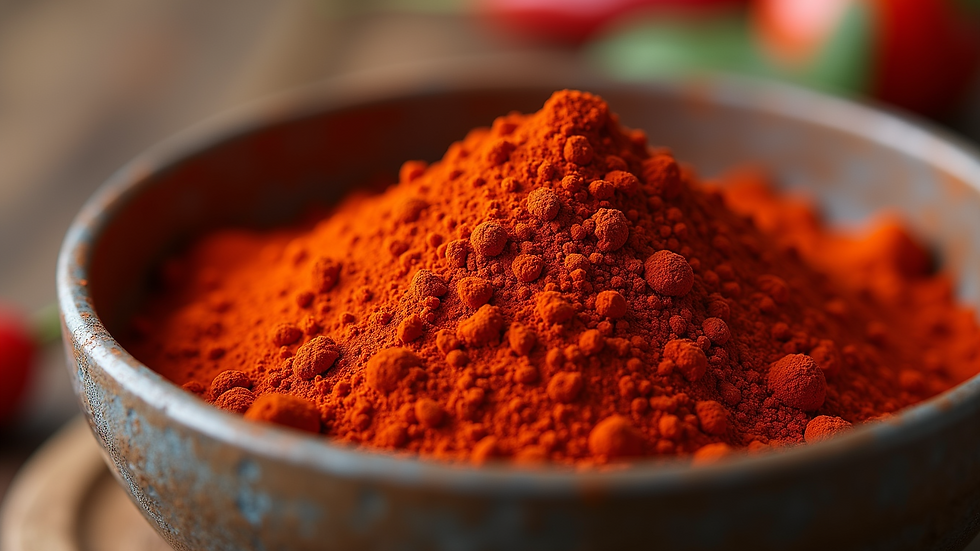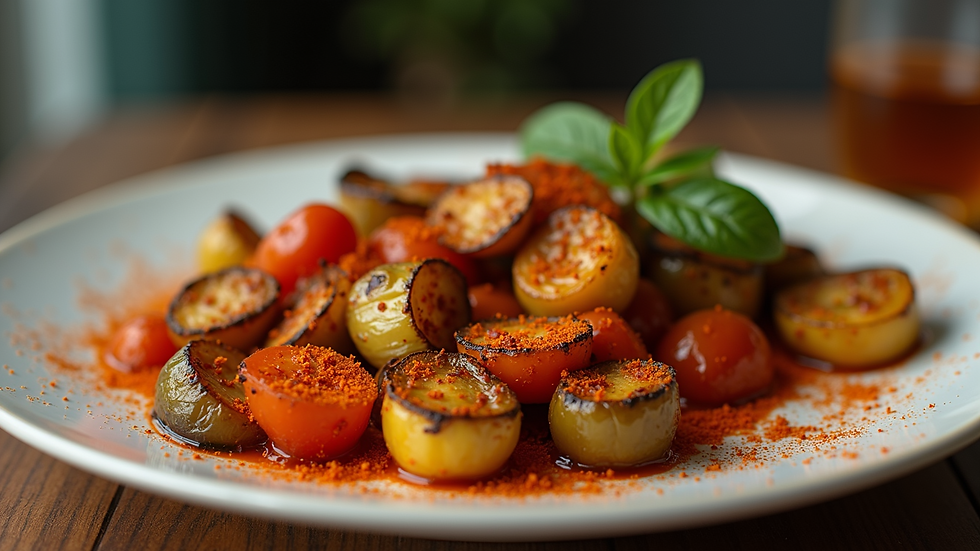Uses of Paprika in Cooking: From Cajun Chicken to Comfort Food Classics.
- Bake Braise & Blaze
- Aug 4
- 3 min read
Updated: Sep 4
Paprika is a vibrant spice that adds more than just color to your dishes. It brings a unique flavor profile that can transform everyday meals into something special. Whether you prefer a mild sweetness or a smoky kick, paprika offers versatility that every kitchen can benefit from. This article explores the many uses of paprika in cooking, practical tips for incorporating it, and the best food pairings to elevate your culinary creations.
The Uses of Paprika in Cooking: A Flavorful Journey
Paprika is made from ground dried peppers, and its flavor can range from sweet and mild to hot and smoky. This spice is a staple in many cuisines, including Hungarian, Spanish, and Moroccan. Its uses in cooking are diverse:
Seasoning for meats: Paprika enhances the flavor of chicken, pork, and beef. It can be used as a dry rub or mixed into marinades.
Color enhancer: Its rich red hue adds visual appeal to dishes like stews, soups, and rice.
Flavor base: Paprika is often the foundation of spice blends, contributing depth and warmth.
Garnish: Sprinkling paprika on deviled eggs or potato salad adds a pop of color and subtle flavor.
When using paprika, it’s important to add it at the right time. For example, adding it early in cooking allows the spice to release its oils and deepen the flavor. However, if you want a fresher taste, sprinkle it on at the end.

How to Use Paprika to Maximize Flavor
To get the most out of paprika, consider these tips:
Choose the right type: Sweet paprika is great for mild dishes, smoked paprika adds a barbecue-like flavor, and hot paprika brings heat.
Store properly: Keep paprika in an airtight container away from light and heat to preserve its flavor.
Use in spice blends: Combine paprika with garlic powder, cumin, and black pepper for a versatile seasoning mix.
Balance flavors: Pair paprika with acidic ingredients like lemon juice or vinegar to brighten dishes.
Experiment with cooking methods: Try paprika in roasted vegetables, grilled meats, or creamy sauces.
Paprika pairs wonderfully with a variety of foods, enhancing their natural flavors without overpowering them. Here are some excellent matches:
Potatoes: Roasted, mashed, or fried potatoes benefit from a dusting of paprika for color and taste.
Eggs: Deviled eggs or scrambled eggs become more appealing with a sprinkle of paprika.
Seafood: Paprika complements fish and shellfish, especially in dishes like paella or grilled shrimp.
Vegetables: Roasted peppers, carrots, and cauliflower gain a smoky or sweet note from paprika.
Soups and stews: Paprika adds warmth and depth to hearty dishes like goulash or lentil soup.
Using paprika in these foods can elevate simple recipes into memorable meals. Try adding paprika to your next vegetable roast or seafood dish for a flavorful twist.

Creative Recipes Featuring Paprika
Incorporating paprika into your cooking can be both fun and rewarding. Here are some creative recipe ideas:
Paprika Chicken Thighs: Marinate chicken thighs in olive oil, garlic, lemon juice, and smoked paprika. Roast until tender and serve with a side of roasted potatoes.
Paprika-Spiced Hummus: Blend chickpeas with tahini, lemon juice, garlic, and sweet paprika for a smoky dip.
Paprika Roasted Cauliflower: Toss cauliflower florets with olive oil, salt, and hot paprika. Roast until crispy and golden.
Paprika Beef Stew: Brown beef cubes and simmer with onions, garlic, tomatoes, and a generous amount of paprika for a rich, comforting stew.
These recipes showcase the versatility of paprika and how it can be adapted to different cuisines and tastes.

Tips for Buying and Storing Paprika
To ensure you get the best quality paprika, keep these points in mind:
Buy whole peppers if possible: Grinding your own paprika from dried peppers preserves freshness and flavor.
Check the color: Bright red paprika indicates freshness and quality.
Avoid pre-ground blends: Pure paprika without additives offers the best taste.
Store in a cool, dark place: Heat and light degrade the spice quickly.
Use within six months: For optimal flavor, use paprika within half a year of purchase.
Proper storage and selection will make a noticeable difference in your dishes.
Elevate Your Cooking Experience with Paprika
Paprika is more than just a spice - it’s a tool to enhance your cooking and bring new dimensions to your meals. From its vibrant color to its complex flavor, paprika can transform simple ingredients into culinary delights. Whether you are seasoning meats, adding depth to soups, or garnishing your favorite dishes, paprika offers endless possibilities.
By understanding the uses of paprika in cooking and experimenting with different types and recipes, you can unlock a world of flavor.
Start your paprika journey today and watch your meals come alive with color and taste!









Comments